Change Management in Contract and Project Execution
Introduction:

In the dynamic landscape of business, contract and project execution have become increasingly complex endeavors. Organizations face an array of challenges ranging from evolving market demands to technological advancements, all of which necessitate the ability to adapt and respond effectively. The success of any project or contract hinges on the organization’s capacity to navigate these changes smoothly. This is where change management steps in as a critical framework for steering projects towards success. In this chapter, we delve deep into the multifaceted realm of change management, exploring its definition, key principles, best practices, real-world case studies, and its undeniable significance in mitigating risks and ensuring project success.
Understanding Change Management:

Change management can be succinctly defined as the structured approach an organization employs to transition individuals, teams, and the entire organization from the current state to a desired future state. It encompasses a set of processes, tools, and techniques to manage and control change within an organization. Change management becomes particularly pertinent in the context of project execution and contract management due to the inevitable shifts and alterations that arise during their lifecycles.
Importance of Change Management in Contract and Project Execution
Change management is essential in contract and project execution as it helps organizations manage the complexity and uncertainty associated with change. It ensures that changes are effectively planned, communicated, and implemented, minimizing the disruptions caused by change and maximizing the chances of project success.
Key Principles of Change Management:
Change management draws from a set of guiding principles that provide a strong foundation for its implementation:
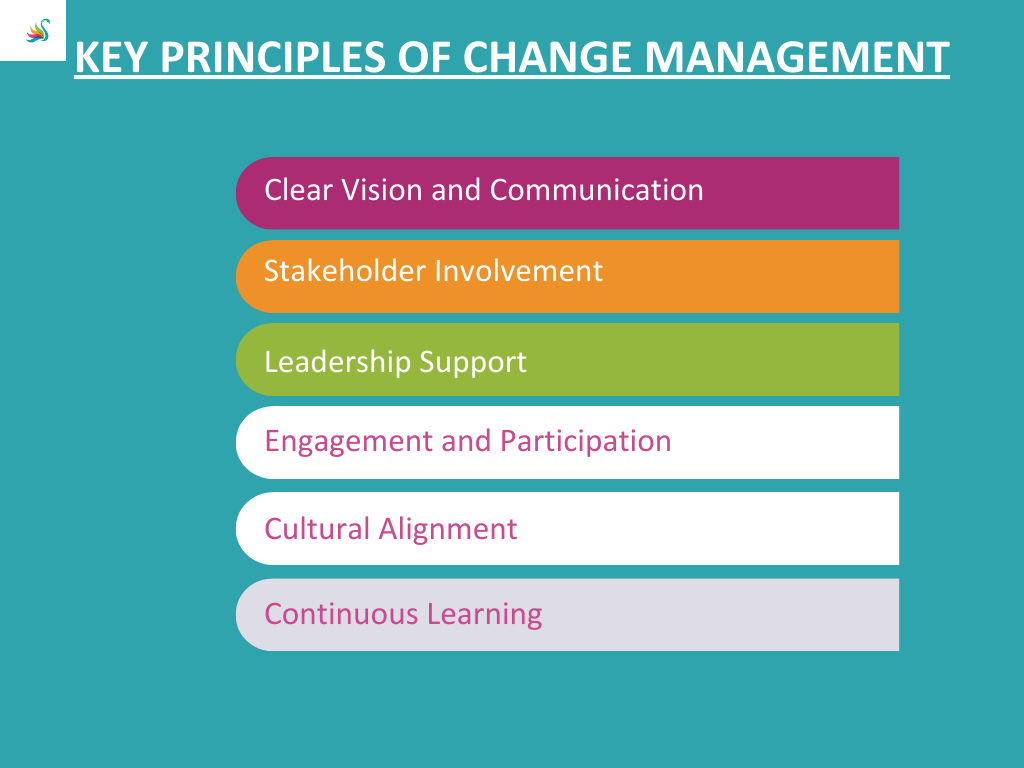
Clear Vision and Communication: An unambiguous vision of the future state serves as a compass for all stakeholders. Effective communication about the rationale, benefits, and impacts of change fosters understanding and support.
Stakeholder Involvement: Involving key stakeholders at all stages of the change process increases ownership and reduces resistance. Their input helps shape strategies and identify potential challenges.
Leadership Support: Strong leadership support and commitment to change are pivotal. Leaders set the tone, demonstrate commitment, and inspire others to follow suit.
Engagement and Participation: Engaging employees in the planning and decision-making processes empowers them and minimizes the feeling of change being imposed upon them.
Cultural Alignment: Aligning the change effort with the existing organizational culture promotes acceptance and minimizes disruption. A cultural shift might be needed in some cases to accommodate new processes or systems.
Continuous Learning: A culture of continuous learning and improvement should be cultivated, allowing teams to adapt and innovate as changes unfold.
Change Management Models and Frameworks:
Change management models and frameworks are essential tools for effectively managing change within contracts and projects. They provide structured approaches to understand, plan, and implement changes while minimizing disruptions and maximizing benefits. Here are some change management models and frameworks commonly used in the context of contracts and projects:
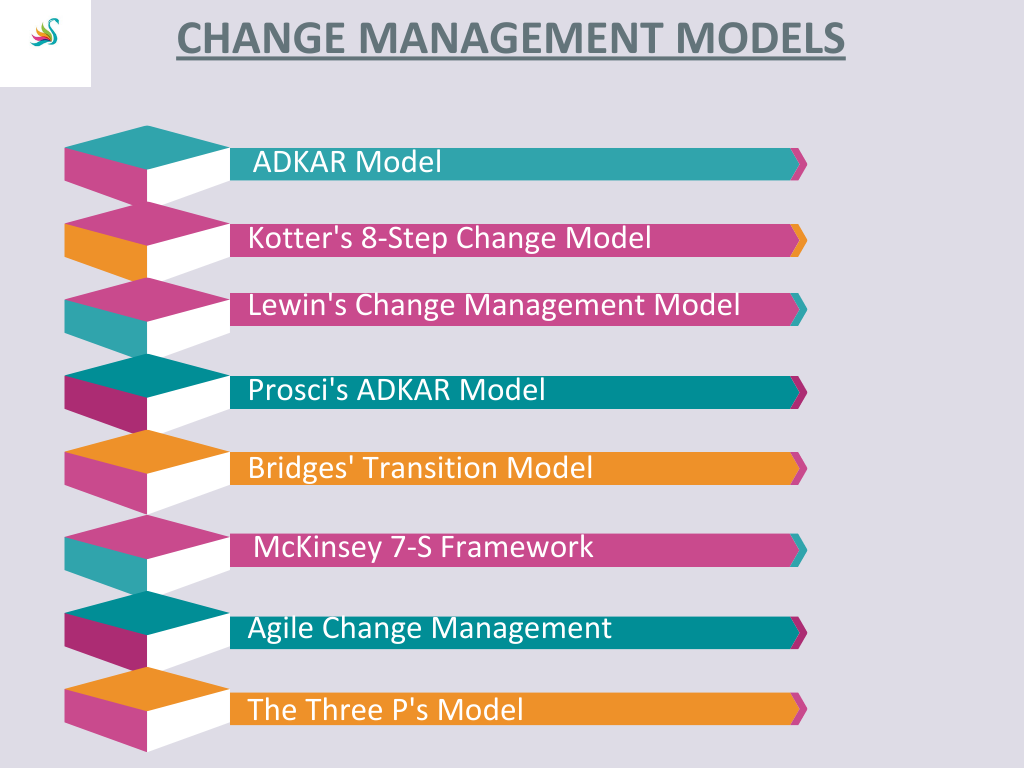
1. ADKAR Model: ADKAR stands for Awareness, Desire, Knowledge, Ability, and Reinforcement. This model focuses on individual change and is particularly useful for managing change within project teams. It outlines the stages an individual goes through when adapting to change, helping managers address resistance and ensure successful adoption.
Awareness: In this stage, individuals need to become aware of the need for change. This involves understanding why the change is happening, what it involves, and what the implications are. Awareness helps create a sense of urgency and highlights the reasons for moving away from the current state.
Desire: After becoming aware of the change, individuals need to develop a desire or motivation to support the change. This requires understanding how the change will personally benefit them or align with their values and aspirations. A strong desire to embrace the change can help overcome resistance and encourage active engagement.
Knowledge: Knowledge refers to the information and skills individuals need to understand how to implement the change. Providing clear and comprehensive information about the change, its processes, and expected outcomes is essential. Proper training and education enable individuals to feel confident about their ability to adapt to the new situation.
Ability: Having knowledge isn’t sufficient; individuals must also possess the ability to implement the change effectively. This stage focuses on providing the necessary tools, resources, and support to help individuals apply their knowledge and carry out the new tasks, processes, or behaviors.
Reinforcement: To ensure the change sticks and becomes a lasting part of the organization’s culture, reinforcement is crucial. Reinforcement involves recognizing and rewarding individuals for adopting the change, celebrating successes, and addressing any challenges that may arise
Uses: This model is applicable across industries where individual behavior change is critical, such as healthcare, retail, and finance. It’s particularly useful when introducing new processes or technologies that require staff to adapt.
2. Kotter’s 8-Step Change Model: Developed by John Kotter, this model provides a step-by-step approach to guide organizations through significant changes. It emphasizes the importance of creating a sense of urgency, building a guiding coalition, and maintaining continuous communication to ensure that change is implemented successfully.
Uses: This model is often used in large corporations, government organizations, and educational institutions. It’s suitable for industries undergoing significant structural or cultural transformations.
3. Lewin’s Change Management Model: Kurt Lewin’s model involves three stages: Unfreeze, Change, and Refreeze. Unfreeze involves preparing the organization or team for change by identifying and addressing resistance. The Change phase involves implementing the actual change, and Refreeze focuses on solidifying the change as the new norm.
Uses: This model is widely applicable across industries, including manufacturing, healthcare, and technology. It’s particularly effective for organizations undergoing process improvements or implementing new technology.
4. Prosci’s ADKAR Model: This extension of the ADKAR model by Prosci adds process-oriented components, making it suitable for guiding changes within projects and contracts. It emphasizes creating a structured approach to change management that includes assessments, plans, and interventions.
Uses: This process-oriented framework is applicable to industries such as pharmaceuticals, energy, and information technology. It’s helpful for systematic change implementations.
5. Bridges’ Transition Model: William Bridges’ model focuses on managing the human side of change. It emphasizes the emotional and psychological aspects individuals experience during transitions. It consists of three stages: Ending, Neutral Zone, and New Beginning, which help people navigate change more effectively.
Uses: It’s often used in industries undergoing significant structural changes, such as manufacturing (plant relocations) and corporate mergers and acquisitions.
6. McKinsey 7-S Framework: While not exclusively a change management framework, the McKinsey 7-S model can be used to manage change by assessing seven interconnected elements: Strategy, Structure, Systems, Shared Values, Skills, Style, and Staff. It ensures that all aspects of the organization are aligned when undergoing change.
Uses: The McKinsey 7-S Framework is versatile and can be used across industries. It’s often employed in management consulting to assess the alignment of various components during strategic shifts.
7. Agile Change Management: This approach integrates change management practices with Agile project methodologies. It involves iterative and incremental changes, focusing on continuous feedback, flexibility, and adaptability to effectively manage changes in dynamic project environments.
Uses: Agile Change Management is popular in tech companies, software development, and startups. It suits industries where rapid adaptation and innovation are crucial.
8.The Three P’s Model: This model addresses the People, Process, and Performance aspects of change. It emphasizes the importance of involving people in the change process, optimizing processes to accommodate changes, and evaluating performance to ensure that desired outcomes are achieved.
Uses: This model is widely applicable across industries, including manufacturing, healthcare, Information technology, Service industries, Education Sector, and in project management.
Benefits of Effective Change Management:
Effective change management brings several benefits to contract and project execution, including:
- Minimizing project delays and cost overruns
- Enhancing stakeholder satisfaction
- Accelerating adoption of new processes or technologies
- Reducing resistance to change
- Mitigating risks associated with change
- Improving employee morale and engagement
Best Practices in Change Management
Implementing effective change management requires a strategic and systematic approach. Here are some best practices that organizations can follow:
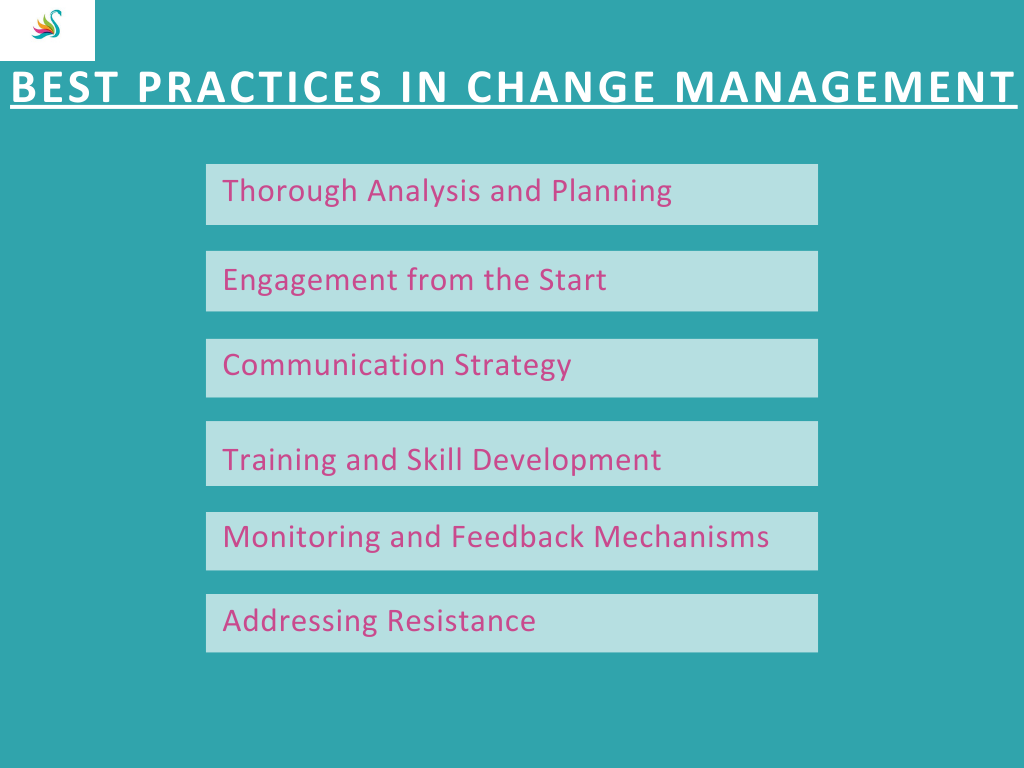
Thorough Analysis and Planning: Conduct a comprehensive analysis of the change’s potential impacts, risks, and benefits. Develop a well-thought-out plan that outlines roles, responsibilities, timelines, and communication strategies.
Engagement from the Start: Involve stakeholders from the outset to ensure their concerns and perspectives are considered in the change process.
Communication Strategy: Design a clear and consistent communication strategy that addresses the “why,” “what,” and “how” of the change. Tailor messages to different audiences and provide opportunities for questions and feedback.
Training and Skill Development: Equip employees with the necessary skills and knowledge to adapt to the changes. Training should be ongoing and tailored to individual needs.
Monitoring and Feedback Mechanisms: Implement mechanisms to gather feedback and monitor the progress of the change. Regular check-ins allow for course corrections and adjustments based on real-time insights.
Addressing Resistance: Anticipate resistance and proactively address it. Engage with resistant individuals or groups to understand their concerns and provide support.
Real-World Case Studies:
Case Study 1: The Boeing 787 Dreamliner
The development of the Boeing 787 Dreamliner serves as a compelling example of the significance of change management in project execution. Boeing aimed to revolutionize the aviation industry by introducing advanced materials and manufacturing techniques. However, challenges arose due to global supply chain complexities, design changes, and technical glitches.
Boeing’s proactive change management approach involved engaging suppliers early, fostering collaboration, and addressing technical issues swiftly. The project faced delays, but the systematic change management strategies minimized disruptions, built stakeholder trust, and ultimately led to the successful launch of the Dreamliner.
Case Study 2: Procter & Gamble’s SAP Implementation
Procter & Gamble’s (P&G) implementation of an enterprise-wide SAP system illustrates the importance of change management in technology projects. The aim was to streamline operations and enhance efficiency. However, the project encountered resistance from employees accustomed to existing processes.
P&G employed change management principles by involving employees in the system design, providing extensive training, and creating user-friendly interfaces. This approach reduced resistance, enhanced user adoption, and resulted in improved operational efficiency.
Impact of Effective Change Management on Project Outcomes
Effective change management significantly influences the success of projects and contract execution. It mitigates the risks associated with resistance, confusion, and productivity loss. Organizations that embrace change management experience:
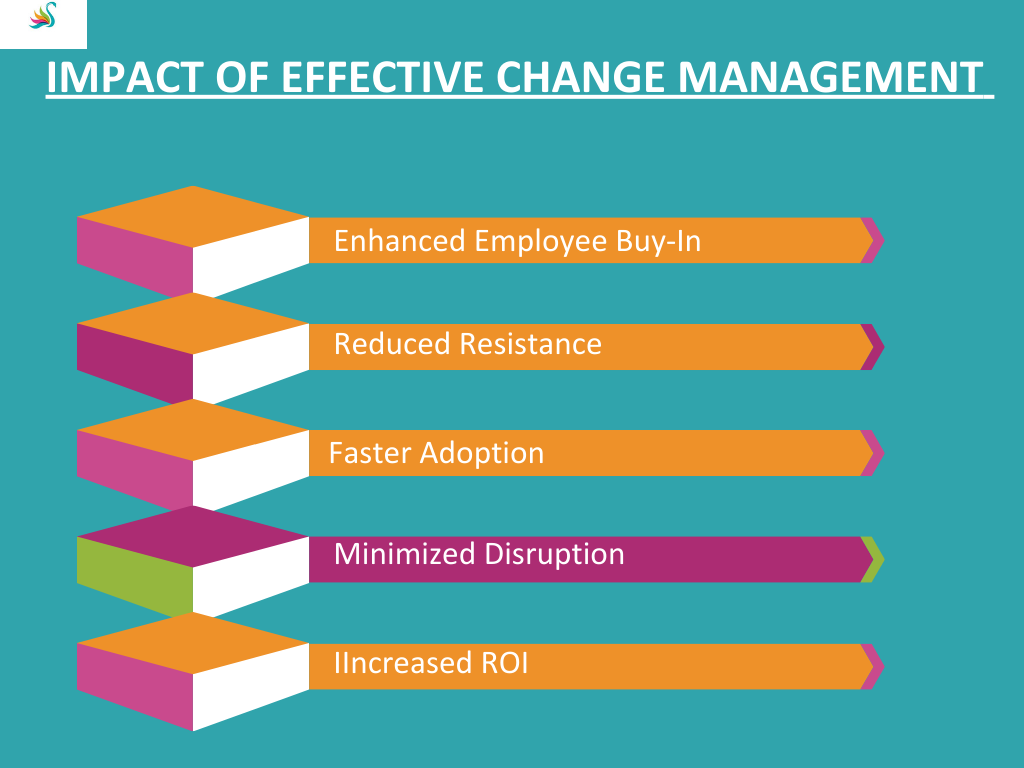
Enhanced Employee Buy-In: Engaged employees are more likely to support and actively participate in the change process. Their enthusiasm can drive the project’s success.
Reduced Resistance: Addressing resistance through open communication and involvement minimizes the negative impact of change on productivity and morale.
Faster Adoption: Change management accelerates the adoption of new processes, technologies, or systems, leading to quicker returns on investment.
Minimized Disruption: A structured approach to change ensures that disruptions are managed, and the organization’s core functions remain operational.
Increased ROI: Well-managed change enhances the likelihood of achieving project goals, which directly impacts the project’s return on investment.
Challenges in Implementing Change Management:
While change management offers numerous benefits, its implementation is not without challenges:
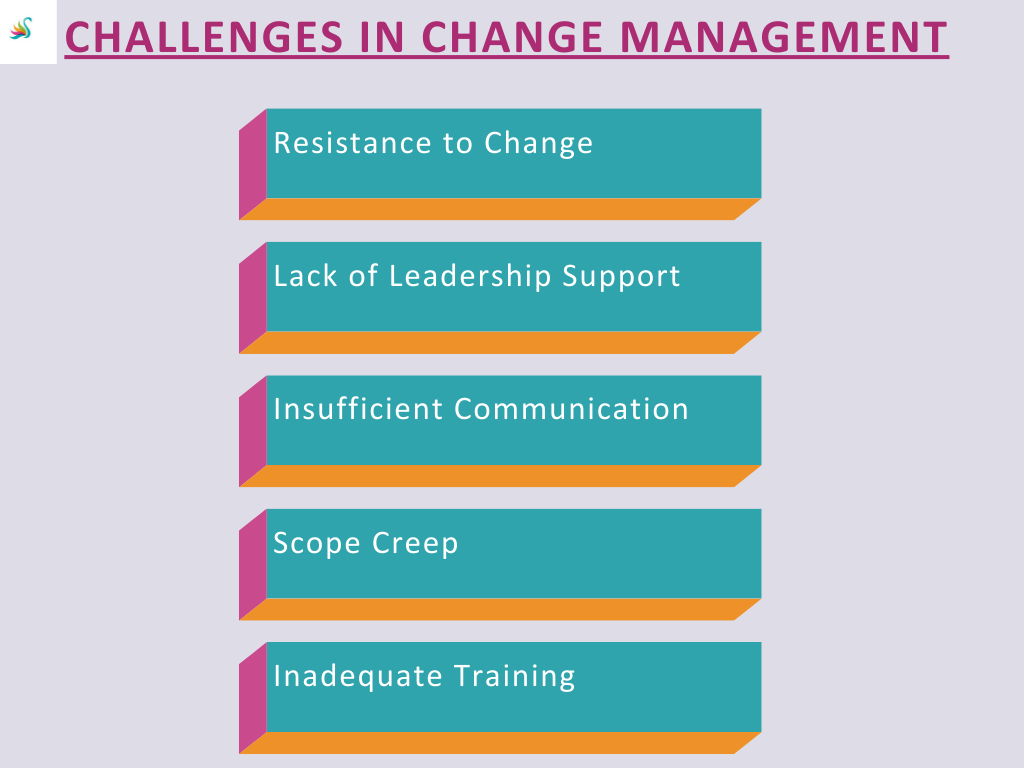
Resistance to Change: Employees may resist change due to fear of the unknown, comfort with existing processes, or perceived threats to job security.
Lack of Leadership Support: Without strong leadership backing, change initiatives can lose momentum and fail to gain traction.
Insufficient Communication: Inadequate or unclear communication about the change can lead to misunderstandings and misinformation.
Scope Creep: Expanding the scope of a project mid-way can derail the change management plan and lead to confusion.
Inadequate Training: Without proper training, employees may struggle to adapt to new systems or processes, leading to frustration and decreased productivity.
Strategies to Overcome Challenges:
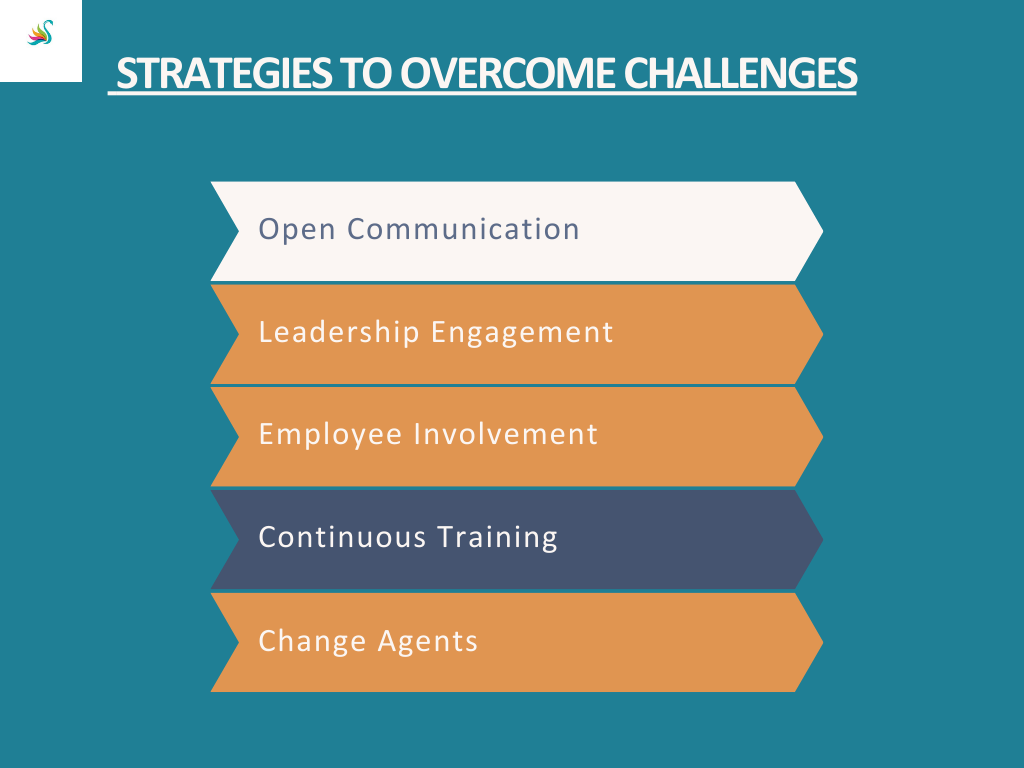
Open Communication: Transparent communication about the reasons for change, its benefits, and potential challenges helps alleviate concerns and build trust.
Leadership Engagement: Leaders should actively support and participate in the change process, demonstrating commitment and setting an example.
Employee Involvement: Involving employees in decision-making and planning empowers them and reduces resistance.
Continuous Training: Ongoing training ensures that employees are equipped with the skills needed to succeed in the changed environment.
Change Agents: Designate change champions within the organization who can guide and support teams through the change process.
Conclusion:

In the ever-evolving landscape of business, change is inevitable. Successful project execution and contract management demand an agile approach to navigate these shifts effectively. Change management provides a structured framework to steer organizations through transformations, ensuring that the potential pitfalls are minimized and the benefits are maximized. By adhering to key principles and best practices, organizations can enhance employee engagement, reduce resistance, and drive faster adoption of changes. Real-world case studies such as Boeing’s Dreamliner project and Procter & Gamble’s SAP implementation exemplify how effective change management can lead to successful outcomes.
